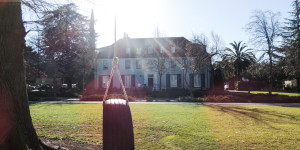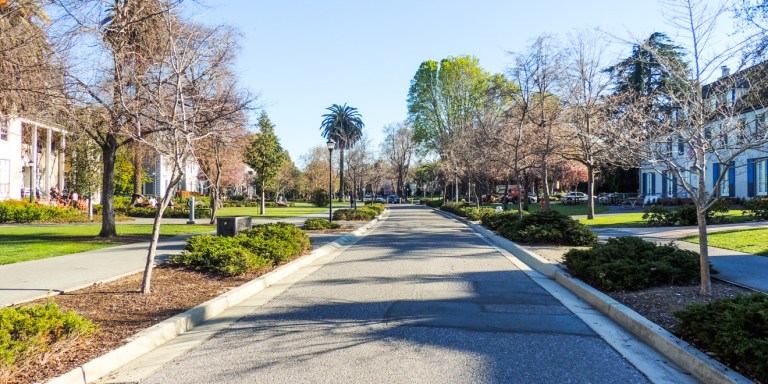Many Stanford students embark on a study abroad program to encounter new cultures or gain a fresh perspective. But students living in Sigma Chi and Columbae have found that cultural immersion and eye opening experiences do not always require an intensive application or a plane ticket.
The Sigma Chi-Columbae house swap was initiated last year when Brett Salazar ’16, a resident of Sigma Chi, thought it would be fun to “study abroad” at Columbae. The experiment was a success and last month the second annual Columbae-Sigma Chi house swap took place. Seven residents from Columbae and six residents from Sigma Chi switched places for three days, sleeping, eating and participating in events at the house across the street from their own.
It is not hard to imagine the comedic element to this swap as Sigma Chi and Columbae are emblematic of drastically different cultures. One of the more blatant disparities is the type of cuisine at each of the houses.
“They’re much more organic and health-focused at Columbae, whereas, here, eating healthy isn’t necessarily a house culture,” said Devin Krok ’17, a resident of Sigma Chi.
However, the fraternity brothers really enjoyed the nutritious fare. “The food [at Columbae] was amazing,” said Dan Isaza ’16, a Sigma Chi resident. “The ingredients are so good.”
For most of the Sigma Chi members, being vegetarian for a few days wasn’t a huge issue, but they agreed it is unlikely that they would adopt it as a lifestyle.
“I love my meat and I was very keen about doing the swap from a social perspective and I totally forgot about the meat thing,” said Ali Baqeri ’16 of Sigma Chi.

For some of the Columbae participants, the lack of vegetarian food was a bit of a challenge. “They [Sigma Chi] have one vegetarian in the house and the cooks always make a special little thing for him, so they would just make a couple extras,” says Amrita Rao, a senior at Columbae.
Jake Glassman ’17, a resident of Columbae, said he missed the Columbae kitchen but “oh my god they have really good processed cereal.”
The sleeping arrangements were also a source of contrast. Andres Hernandez ’17 found it somewhat bizarre that, at Columbae, closets are the most coveted sleeping quarters.
“Everyone wants at least one quarter in a clothing closet,” he remarked. “I’m claustrophobic. There’s no way I could do the exchange if I had to sleep in a closet.”
But some seemingly different setups turned out to be relatively analogous after all. “I got to stay in the ‘penthouse,’” Glassman said. “My friend apologized to me for having to sleep on the floor but I assured him it wasn’t a problem. I live in a commune so I always sleep on the floor.”
There were many aspects of the house cultures that the participants really appreciated. “We hung out on the roof a lot and that was probably one of my favorite parts,” said Damian McGlothlin ’15 of Sigma Chi. “Something that’s cool is that they know what kind of music their house likes and they try to bring in an artist or two every quarter.”
“For me the most special part was not the big events, it was hanging out on the porch,” Baqeri said.
There are even events or house features that the participants would consider bringing back to their own houses.
“They had this one thing called beer-soda-juice fridge where you write what you take and pay it off at the end of the quarter…it would be cool to see it implemented here [at Sigma Chi],” Isaza said.
As for bringing Sigma Chi traditions back to Columbae, Garg appreciated the dinner-time practice of silencing the tables to welcome guests and make announcements.
“They have their plate banging and they introduce the guests during dinner time and I think it’s really cool to know who’s visiting,” Garg said.
The Columbae participants also managed to bestow a gift upon Sigma Chi that they hope will bring about greater environmental awareness.
“We stole one of their trash cans and brought it over here [to Columbae] and I painted recycling symbols on it and wrote, “Our present to you — love, Columbae,” says Rao.“It was well-received. When I was painting it, it was just full of beer cans.”
All the participants agree it was a broadening, enriching experience. “This girl at Columbae picked edible flowers, so I was just sitting on the Columbae porch eating flowers,” Isaza said. “Not something I would imagine myself doing a week before.”

One of the biggest realizations was that the Sigma Chi and Columbae communities might not be so different after all. “The relationship between Columbae and Sigma Chi is very funny because we both eat outside and we’re right across the street and we seem very different on the surface,” Glassman said. “We see what the other house is doing but when we swapped we saw that there’s a lot of common ground and we are both social, fun communities.”
This swap also functioned as a reminder of the plethora of unique communities at Stanford. “For me it served as a fresh reminder that there is life outside this house,” says Baqeri. “When you are in a very strong community like this one [Sigma Chi] it’s easy to make it the default setting. This experience made me more determined to maximize my time here moving forward.”
As for the Sigma Chi-Columbae relationship, this is only the beginning. Ideas for future soccer games and quarterly joint dinners have been suggested. The possibility of doing a similar resident exchange between other houses has also been met with a lot of enthusiasm.
“Columbae is right across the street and it’s a stepping stone but we want to do it with other houses on campus,” McGlothlin said.
Many students seek out enlightening adventures at Stanford, but residents of Columbae and Sigma Chi have discovered that sometimes finding new experiences is as easy as crossing the street.
Contact Michaela Elias at melias23 ‘at’ stanford.edu.
